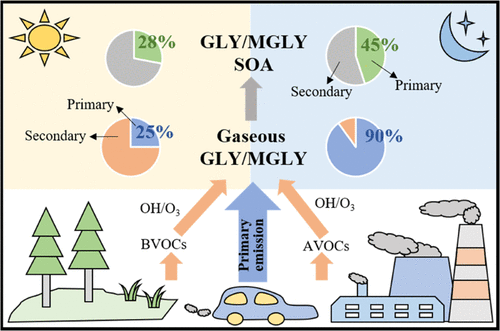当前位置:
X-MOL 学术
›
Environ. Sci. Technol.
›
论文详情
Our official English website, www.x-mol.net, welcomes your feedback! (Note: you will need to create a separate account there.)
Importance of Wintertime Anthropogenic Glyoxal and Methylglyoxal Emissions in Beijing and Implications for Secondary Organic Aerosol Formation in Megacities.
Environmental Science & Technology ( IF 11.4 ) Pub Date : 2020-09-03 , DOI: 10.1021/acs.est.0c02822 Xionghui Qiu 1, 2, 3 , Shuxiao Wang 2, 3 , Qi Ying 4 , Lei Duan 2, 3 , Jia Xing 2, 3 , Jingyuan Cao 1 , Di Wu 2, 3 , Xiaoxiao Li 2, 3 , Xing Chengzhi 5 , Xiao Yan 6 , Cheng Liu 7 , Jiming Hao 2, 3
Environmental Science & Technology ( IF 11.4 ) Pub Date : 2020-09-03 , DOI: 10.1021/acs.est.0c02822 Xionghui Qiu 1, 2, 3 , Shuxiao Wang 2, 3 , Qi Ying 4 , Lei Duan 2, 3 , Jia Xing 2, 3 , Jingyuan Cao 1 , Di Wu 2, 3 , Xiaoxiao Li 2, 3 , Xing Chengzhi 5 , Xiao Yan 6 , Cheng Liu 7 , Jiming Hao 2, 3
Affiliation

|
Atmospheric glyoxal (GLY) and methylglyoxal (MGLY) are key precursors of secondary organic aerosol (SOA). However, anthropogenic emissions of GLY and MGLY and their contribution to surface GLY and MGLY concentrations, as well as the secondary organic aerosol (SOA) formation, are not well quantified. By developing an emission inventory of anthropogenic GLY and MGLY and improving the Community Multiscale Air Quality Model (CMAQ) with SOA formation from irreversible surface uptake of GLY and MGLY, as well as a precursor-origin resolved technique, we quantified the source contributions of GLY and MGLY and their impact on wintertime SOA formation in Beijing, China. The total emissions of GLY and MGLY in Beijing in 2017 are 1.1 × 104 kmol and 7.0 × 103 kmol, respectively. Anthropogenic primary emissions are found to be the dominant contributor to wintertime GLY and MGLY concentrations (∼74% for GLY and ∼63% for MGLY). Anthropogenic primary emissions of GLY and MGLY contributes to 30% of GLY/MGLY SOA daily average concentration and accounts for up to 45% of nighttime GLY/MGLY SOA in winter. The study suggests that the anthropogenic GLY and MGLY emissions, mainly from gasoline vehicles and cooking, are important for SOA formation and shall be strictly controlled in Chinese megacities.
更新日期:2020-10-06



























 京公网安备 11010802027423号
京公网安备 11010802027423号